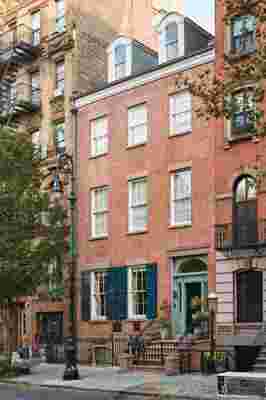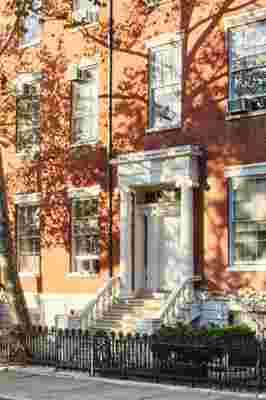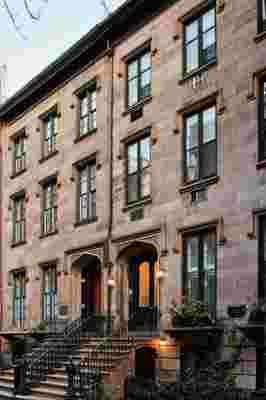In 1972, 24-year-old writer and architectural historian Charles Lockwood published what would become his seminal work, Bricks and Brownstone: The New York Row House 1783–1929 , the first and, to this day, only encyclopedic book dedicated to New York City’s most famous type of residential dwelling. The tome’s debut coincided with the rise in interest in architectural preservation—the New York City Landmarks Preservation Commission was established just seven years prior, in 1965, and the New York Landmarks Conservancy followed in 1971—as the city grappled with rapid growth. Ultimately, the book inspired renewed interest in the historic row houses across Manhattan and Brooklyn, and even served as reference material for many row houses’ renovations. In 2003, a revised and expanded version of the book was published by Rizzoli, and today Bricks & Brownstone is getting a third renovation. Writer Patrick W. Ciccone and photographer Dylan Chandler have updated the book with even more new research and new images, with the new edition being released this month ( $85, Rizzoli ). Here, get a sneak peek of 10 different architectural styles of New York row houses as discussed in the book.
Federal Style

In the decades after the Revolutionary War, New York experienced a population (and economic) boom, which led to the building of numerous row homes. Between the 1780s and 1830s, the red-brick Federal Style dominated the streets—it was a look greatly inspired by the English Georgian style, with nods to the classical tradition. “The pervasive British influence in American architecture in the late 18th and early 19th centuries confirmed that the Revolutionary War had been a political, not cultural, revolution,” writes Ciccone.
Greek Revival

Between 1830 and 1850, Greek Revival architecture overtook the Federal style, not just in New York, but across the United States. For row houses specifically, the movement was quite subtle—façades were still made of red brick, but Ionic and Doric columns adorned doorways, while ornamental work featured Greek motifs like the acanthus leaf.
Gothic Revival

While local brownstone was frequently used in New York construction before the 1850s—it was the material of choice for many churches, like the Gothic Revival Trinity Church, completed in 1846—it soon made the jump to residential dwellings. But given the cramped streets, true Gothic Revival style never took hold with the row houses. Instead, details were added through ironwork in fences, balconies, and stoop railings.
Italianate
Architects quickly moved from Gothic Revival to the Italianate mode between the 1850s and 1870s, taking inspiration from Italian palazzi while still using local brownstone. These façades featured curved lines and delicate ornamentation to produce an elegant effect.
Second Empire
During the same time period, some Italianate row houses began to incorporate the Second Empire style into their architecture—see the mansard roofs here. “The Second Empire style did not reach American architects directly from Paris but apparently came indirectly from the Parisian-inspired hotels built in London in the mid-1850s,” writes Ciccone.
Neo-Grec
By the 1870s, the Italianate style was fading in favor of the Neo-Grec style, a simpler, less ornamental mode that was more rectangular in nature than the rounded forms found in Italianate row homes—but the use of brownstone still prevailed.
Queen Anne
For just a short decade, Queen Anne façades overtook the streets. Rather than being a formal style in its own, Queen Anne served more as a catchall phrase for row houses that had more individuality and ornamentalism in their design—think irregular plans, pitched-gable rooflines, and decorative reliefs. While brownstone was still used, brick and terra-cotta were added to the mix, as was wood trim.
Romanesque Revival
Rising in popularity at the same time as the Queen Anne style, Romanesque Revival row houses also featured asymmetrical plans and more individualistic façades with varied materials (limestone and granite made appearances here) and decoration. But Romanesque Revival architecture feels heavier than Queen Anne, thanks to features like large grand arches around doorways and windows.
Renaissance Revival
From the 1880s through the 1890s, New York architects began turning to the optimism of the Renaissance for inspiration, building row homes that ranged from the academically accurate to the more whimsical in nature. “Though grouped under the general label of the Renaissance Revival style, these houses took inspiration and much form and ornament from many sources—Roman, the Beaux-Arts, Italian Renaissance, French Renaissance, French classic, and German Renaissance, among others,” writes Ciccone. “The Renaissance Revival dwelling relied upon applied detail for its stylistic impact, with the most popular motifs being wreaths, baskets of fruit, garlands of flowers and leaves tied with ribbons at the ends, and numerous foliate forms.”
Colonial Revival
By the 1890s into the first two decades of the 20th century, architects were revisiting the earlier Federal style in what would be dubbed the Colonial Revival (a misnomer, since the Federal style postdated American independence), in part inspired by the Centennial Exhibition of 1876 in Philadelphia. As such, brick took priority over brownstone, limestone, and granite on façades. After the turn of the 20th century, row homes began to fade in popularity, as apartment buildings were on the rise.
© Bricks & Brownstone: The New York Row House by Charles Lockwood and Patrick W. Ciccone, Rizzoli New York, 2019.
